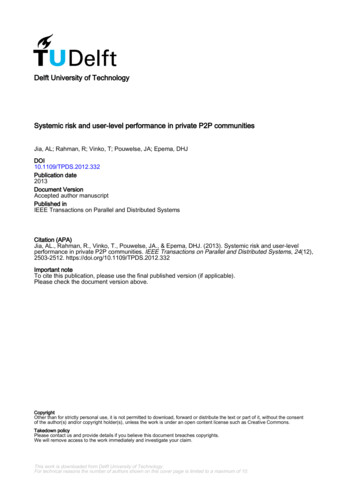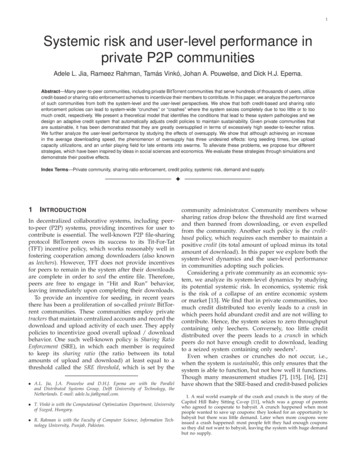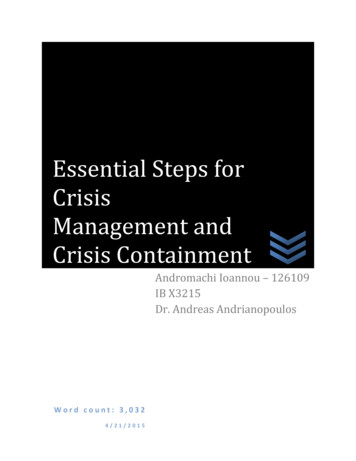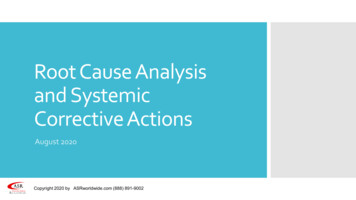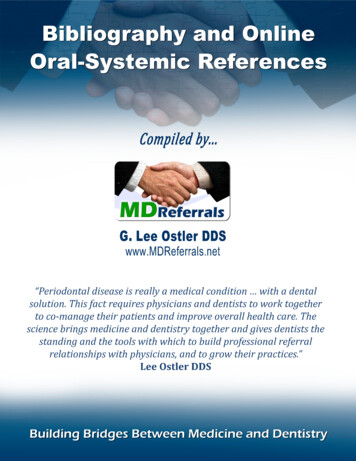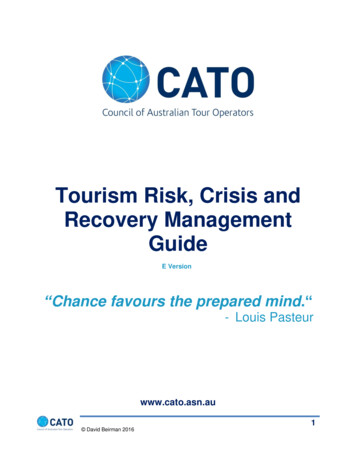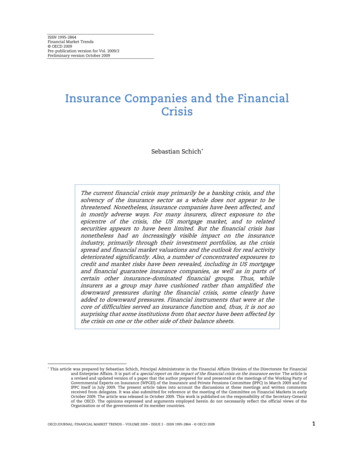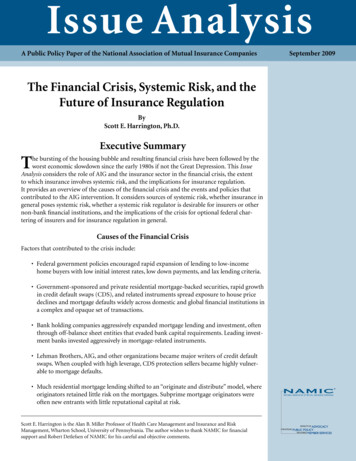
Transcription
Issue AnalysisA Public Policy Paper of the National Association of Mutual Insurance CompaniesThe Financial Crisis, Systemic Risk, and theFuture of Insurance RegulationByScott E. Harrington, Ph.D.Executive SummaryThe bursting of the housing bubble and resulting financial crisis have been followed by theworst economic slowdown since the early 1980s if not the Great Depression. This IssueAnalysis considers the role of AIG and the insurance sector in the financial crisis, the extentto which insurance involves systemic risk, and the implications for insurance regulation.It provides an overview of the causes of the financial crisis and the events and policies thatcontributed to the AIG intervention. It considers sources of systemic risk, whether insurance ingeneral poses systemic risk, whether a systemic risk regulator is desirable for insurers or othernon-bank financial institutions, and the implications of the crisis for optional federal chartering of insurers and for insurance regulation in general.Causes of the Financial CrisisFactors that contributed to the crisis include: Federal government policies encouraged rapid expansion of lending to low-incomehome buyers with low initial interest rates, low down payments, and lax lending criteria. Government-sponsored and private residential mortgage-backed securities, rapid growthin credit default swaps (CDS), and related instruments spread exposure to house pricedeclines and mortgage defaults widely across domestic and global financial institutions ina complex and opaque set of transactions. Bank holding companies aggressively expanded mortgage lending and investment, oftenthrough off-balance sheet entities that evaded bank capital requirements. Leading investment banks invested aggressively in mortgage-related instruments. Lehman Brothers, AIG, and other organizations became major writers of credit defaultswaps. When coupled with high leverage, CDS protection sellers became highly vulnerable to mortgage defaults. Much residential mortgage lending shifted to an “originate and distribute” model, whereoriginators retained little risk on the mortgages. Subprime mortgage originators wereoften new entrants with little reputational capital at risk.Scott E. Harrington is the Alan B. Miller Professor of Health Care Management and Insurance and RiskManagement, Wharton School, University of Pennsylvania. The author wishes to thank NAMIC for financialsupport and Robert Detlefsen of NAMIC for his careful and objective comments.September 2009
The Federal Reserve kept interest ratesat historically low levels, which fueledhousing demand and encouragedlenders to relax mortgage-lendingcriteria.The Paradox of AIG Apart from AIG, the insurance sectoras a whole was largely on the peripheryof the crisis. The AIG crisis was heavilyinfluenced by its CDS portfolio, soldby a non-insurance entity, AIG Financial Products (AIGFP), which was notsubject to insurance regulation.The AIG crisiswas heavilyinfluenced by itsCDS portfolio, soldby a non-insuranceentity, AIGFinancial Products(AIGFP), whichwas not subjectto insuranceregulation. Rating downgrades and declines invalues of securities on which AIGFPhad written credit default swapscaused it to have to post large amountsof collateral. AIG also ran into majorproblems with the securities lendingprogram of its life insurance subsidiaries when borrowers requested thereturn of large amounts of collateral.AIG’s overall investment portfoliowas significantly exposed to loss fromreductions in values of mortgagerelated securities. Much of the federal government’sfinancial assistance to AIG wasprovided for the benefit of AIG’s CDSand securities lending counterparties, primarily domestic and foreignbanking and investment banking organizations. It is not clear that any ofAIG’s insurance subsidiaries wouldhave become insolvent if the FederalReserve had not intervened. AIG was subject to consolidated regulation and oversight by the federalOffice of Thrift Supervision and wasrecognized as such for meeting the2005 E.U. regulatory criterion forgroup supervision of financial serviceentities. If the financial crisis andAIG intervention are to be blamedon ineffective regulation, the blameshould reflect the substantial evidence2of fundamental failures in U.S. andforeign banking regulation.Systemic Risk and the Crisis Systemic risk refers to the risk of widespread harm to financial institutionsand associated spillovers on the realeconomy that may arise from interdependencies among those institutions and associated risk of contagion.Systemic risk is conceptually distinctfrom the risk of common shocks to theeconomy, such as widespread reductions in housing prices, which have thepotential to harm large numbers ofpeople and firms directly (i.e., withoutcontagion). Possible sources of systemic riskinclude: (1) a shock may cause oneor more financial institutions to selllarge amounts of assets at temporarilydepressed prices, further depressingprices and market values of institutions that hold similar assets; (2)shocks to some firms may make themunable to honor their commitments,causing some of their counterpartiesto likewise default, with repercussionsthat cascade through financial markets;(3) revelation of financial problems atsome institutions may create uncertainty about the effects on counterparties and whether other institutionsface similar problems, so that partiesbecome reluctant to trade until furtherinformation becomes available; and (4)possibly irrational contagion, whereinvestors and/or customers withdraw funds without regard to whetherspecific institutions are at risk. Prior research, which largely predatesthe growth of credit default swapsand complex securitizations, providesalmost no evidence of irrational contagion and little evidence of contagionrelated to counterparty risk, assetprices, or uncertainty/opacity.
The AIG crisis and general financial crisis were precipitated by thebursting of the housing price bubbleand attendant increases in actual andexpected mortgage defaults, whichgreatly reduced the values of mortgage-related securities as new information was reflected in prices. Whilethere apparently were some elementsof contagion, the principal problemwas the decline in security values. Whether AIG’s CDS portfolio andsecurities lending presented significant risk of contagion has and willbe debated. Little is known about theextent to which an AIG bankruptcywould have had significant adverseeffects beyond its counterparties, oreven the extent to which its counterparties had hedged their bets withAIG or otherwise reduced their risk.Systemic Risk in Insurance Systemic risk is low in insurancemarkets compared with banking,especially for property/casualty insurance, in part because insurers holdgreater amounts of capital in relation to their liabilities, reducing theirvulnerability to shocks. Moreover,shocks to insurers do not threaten theeconomy’s payment system, as mightbe true for shocks to commercialbanks. Banking crises have the potential toproduce rapid and widespread harmto economic activity and employment, which provides some rationale for relatively broad governmentguarantees of bank deposits and strictcapital requirements. Because insurance, especially property/casualty,poses much less systemic risk, there isless need for broad government guarantees to prevent potentially widespread runs that would destabilize theeconomy. Insurance guarantees haveappropriately been narrower in scopethan in banking, and market disciplineis generally strong. Capital requirementshave been much less binding – insurerscommonly have held much more capitalthan required by regulation.Proposed Regulation of“Systemically Significant” Insurers A June 2009 U.S. Treasury white paperproposes regulation by the FederalReserve of insurance and other nonbank institutions it would designate assystemically significant. A bill introduced by Representatives Melissa Bean(D-Ill.) and Edward Royce (R-Calif.)would create an optional federal chartering system for insurers under whichthe President would designate an agencyas systemic risk regulator for systemically significant state and federally chartered insurers. The agency could forcean insurer to be federally chartered. Strong arguments against creating asystemic risk regulator that could designate insurers and other non-bank financial institutions as being subject tocomprehensive regulation and oversightby the Federal Reserve or other agencyinclude:– Any institution designated “systemically significant” would be regardedas too big to fail, reducing marketdiscipline and aggravating moralhazard.– Implicit or explicit government guarantees of the obligations of any institution designated systemically significant would provide it with a materialcompetitive advantage and lower itscost of capital compared with companies not so designated.– Political pressure, the history of bankcapital regulation, and incentives forregulatory arbitrage make it doubtful3Systemic risk islow in insurancemarkets comparedwith banking,especially forproperty/casualtyinsurance, in partbecause insurershold greateramounts of capitalin relation to theirliabilities.
that stronger capital requirementswould offset the increased moralhazard and unequal competitive advantage versus institutionsnot designated as systemicallysignificant.– A systemic risk regulator could havean incentive to prop up an institution designated systemically significant even if the institution’s financial problems had little potential forsystemic consequences. The argument thatAIG’s problemsand federalintervention makea prima facie casefor a systemic riskregulator of large,interconnectednon-bank financialinstitutions ignoresthe regulatedinsurance sector’smodest role in thecrisis.The argument that AIG’s problemsand federal intervention make a primafacie case for a systemic risk regulator for large and interconnectednon-bank financial institutions doesnot adequately consider the potential benefits and costs. It does notconsider the failures of federal regulation of large banking organizationsthat contributed to the financial crisis.It largely ignores the regulated insurance sector’s comparatively modestrole in the crisis. It provides no guidance for limiting the scope of discretionary federal authority to intervenein the financial sector in particular andthe economy in general. It is hardly certain that a systemic riskregulator would be effective at limitingrisk in a dynamic, global environment.The financial crisis underscores (1) theimperfect nature of federal regulationof banks and related institutions, (2)the necessity of renewed vigilance inbanking oversight and capital requirements, and (3) the desirability ofencouraging additional market discipline in banking. The federal government was able tointervene in AIG and limit any potential contagion without the authorityto regulate AIG ex ante. The questionarises: What would the Federal Reserveor some other federal agency havedone differently if it had systemic risk4authority before and during the crisis?The answer is not clear and has notbeen provided.The Crisis andOptional Federal Chartering The financial crisis and AIG bailouthave not significantly strengthened thecase for optional federal chartering ofinsurers. An assertion that mandatoryfederal chartering should be adoptedfor insurers designated as systemically significant is subject to the arguments against a systemic risk regulatoroutlined above. AIG’s problems cannotbe primarily attributed to any insurance regulatory failure. Given what wecurrently know, AIG would likely havebeen able to largely if not completelymeet its obligations to policyholderswithout federal intervention, with stateinsurance guaranty funds serving as apotentially important backup. In view of what happened at Citibank,Bank of America, and other bank andinvestment bank holding companies, astrong case for federal insurance regulation in response to the crisis wouldhave to explain how federal regulation of AIG before the crisis wouldspecifically have prevented or mitigated its problems. There can be nopresumption that federal regulationof AIG’s insurance operations wouldhave prevented or mitigated risk takingat AIG, or that optional federal chartering with or without mandatoryfederal chartering for large insuranceorganizations would mitigate any roleof insurance in some future financialcrisis. It’s just as likely or more likelythat federal regulation of large insurerswould have further increased risk.Implications forInsurance Regulation1. A primary objective of legislative andregulatory responses to the financial
crisis should be to encourage marketdiscipline as a means to promotesafety and soundness in banking,insurance, and other financial institutions. An overriding goal of anychanges in regulation in response tothe AIG anomaly should be to avoidextending explicit or implicit too-bigto-fail policies.2. The financial crisis and AIG intervention do not justify creation of asystemic risk regulator with authorityover insurers and non-bank institutions designated as “systemicallysignificant.” The creation of a systemicrisk regulator would very likely undermine market discipline and protecteven more institutions, investors, andconsumers from the downside of riskybehavior.3. The financial crisis and AIG intervention do not fundamentally strengthenarguments for either optional ormandatory federal regulation ofinsurance. Systemic risk aside, anydebate over optional federal chartering of insurers should likewiserecognize the central importance ofavoiding expanded government guarantees of insurers’ obligations.4. Recent events do not justify broadauthority for the FDIC or some otherfederal agency to selectively seizeand resolve financial troubled insurance organizations or other nonbanking organizations. The question of whether regulatory authorityfor resolving financially distressed,non-bank organizations should beexpanded in any way deserves morestudy before being given seriousconsideration.5. The financial crisis does not suggestany need for fundamental changesin U.S. insurance company capitalrequirements, which should continueto recognize the distinctive natureof insurance markets. Given limitedsystemic risk and potential for contagion, government guarantees ofinsurers’ obligations are appropriatelynarrower in scope than in banking,and market discipline is reasonablystrong. Strong market discipline favorscapital requirements that generally areeasily met by the bulk of insurancecompanies, reducing potential undesirable distortions of sound companies’operating decisions and incentives forevading the requirements.6. Creating some form of federal insurance information office to provideinformation, serve as a liaison on insurance issues with Congress, and represent the United States in internationalinsurance regulatory forums would besensible, with suitable safeguards ofstate authority. The creation of a federalcouncil to monitor domestic and international financial institutions and theeconomy for developments that couldpose systemic risk and potentially leadto a future crisis could also be useful.IntroductionThe bursting of the housing bubble andresulting financial crisis have beenfollowed by the worst economic slowdownsince the early 1980s if not the Great Depression. As subprime mortgage defaults rose in2007, the Federal Deposit Insurance Corporation (FDIC) closed down a number ofmajor subprime lenders. The Federal Reserverescued investment bank Bear Stearns with a 30 billion guarantee to facilitate its acquisition by J.P. Morgan in March 2008. September15-16, 2008, saw investment bank LehmanBrothers file for bankruptcy, the distressed saleof investment bank Merrill Lynch to Bank ofAmerica, and the announcement of an 85billion bailout of American InternationalGroup (AIG).5The financialcrisis and AIGintervention donot fundamentallystrengthenarguments foreither optional ormandatory federalregulation ofinsurance.
Congress enacted the 700 billion TroubledAsset Relief Program (TARP) in October,which was followed by massive infusionsof capital into numerous banks, includingthe nine largest, along with large guaranteesof bank debt. Other federal interventionsincluded hundreds of billions of dollars ofguarantees to support money market mutualfunds, commercial paper, and numerousasset-backed securities.Many parties madeaggressive betsthat housing priceswould continue torise. It’s also clearthat governmentpolicy andregulatory failurecontributed to thecrisis.The underlying causes of the financial crisisand how it was transmitted across firms,sectors, and borders will be studied anddebated for years. Whatever the causes, thecrisis has led to numerous proposals forchanges in financial regulation, includingthe proposed creation of a systemic riskregulator and expanded federal governmentauthority to resolve financially distressednon-bank institutions. The proposedchanges have been motivated in significantpart by the financial distress, bailout, andquasi-nationalization of AIG, the world’slargest, publicly traded insurance organization. In addition to providing impetusfor the creation of a systemic risk regulatorand expanded federal authority to resolvefinancially distressed non-bank entities,proponents of optional federal charteringof insurers argue that the AIG intervention makes some form of federal charteringessential.This Issue Analysis considers the role of AIGand the insurance sector in the financialcrisis, the extent to which insurance involvessystemic risk, and the implications for insurance regulation. I begin with a brief overview of the causes of the financial crisis. Ithen explore the events and policies thatcontributed to the AIG intervention. Thissynopsis is followed by an elaboration of themeaning of systemic risk and whether insurance in general poses systemic risk. I discusswhether a systemic risk regulator is desirable for insurers or other non-bank financialinstitutions. The last two sections addressthe implications of the crisis for optionalfederal chartering of insurers and for insurance regulation in general.6Causes of the Financial CrisisWhile the varied and complex causes of the2007-2009 financial crisis will be studied anddebated for decades, the popular media haveoften focused on alleged “Wall Street greed,”and, to a lesser extent, the alleged evils offinancial “deregulation.” The early consensusamong researchers and policy analysts is thatincentive compensation arrangements inthe financial sector contributed to aggressiverisk taking in residential mortgages and realestate, and it is possible that certain relaxations in regulation also played a role. It isclear that many parties made aggressive betsthat housing prices would continue to rise orat least not fall, contributing to the housingprice bubble and leading to widespreadfinancial distress when the bubble burst. Itis also clear that a number of governmentpolicy and regulatory failures contributed tothe crisis.While their relative importance is debatable,the following factors all contributed to thecrisis:1 Federal government policies encouraged the Government SponsoredEnterprises (GSEs), Fannie Maeand Freddie Mac, to expand rapidlythrough the early 2000s, in significantpart to support lending to low-incomehome buyers. The Community Reinvestment Act and pressure from theDepartment of Housing and UrbanDevelopment likewise encouragedcommercial banks to expand mortgage lending in low-income, minorityneighborhoods. Subprime and Alt-A mortgage lendingwith low initial interest rates and littlerequired down payment acceleratedduring the middle part of the decadein conjunction with rapid growth inprivate, residential mortgage-backedsecurities and explosive growth incredit default swaps (CDS) and relatedinstruments, which spread exposureto house price declines and mortgage
defaults widely across domestic andglobal financial ins
of the crisis. The AIG crisis was heavily influenced by its CDS portfolio, sold by a non-insurance entity, AIG Finan-cial Products (AIGFP), which was not subject to insurance regulation. Rating downgrades and declines in values of securities on which AIGFP had written credit default swa
